“Seeing likeness in a portrait is to recognize the craftsman in the artist. Finding soul is to discover the artist in the craftsman.” – Bernard Poulin (4 Jan 1945 – )
 2017: Friends • a new series of portraits painted with acrylics on waxed natural-colored plywood-panels measuring 13″ square, using only four colors – white, black, yellow ochre, & red ochre. I have never used such a limited palette of colors to try to express flesh tones, always having used a variety of earth tones such as the siennas and umbers – both raw and burnt – to attempt portraying 3-
2017: Friends • a new series of portraits painted with acrylics on waxed natural-colored plywood-panels measuring 13″ square, using only four colors – white, black, yellow ochre, & red ochre. I have never used such a limited palette of colors to try to express flesh tones, always having used a variety of earth tones such as the siennas and umbers – both raw and burnt – to attempt portraying 3-
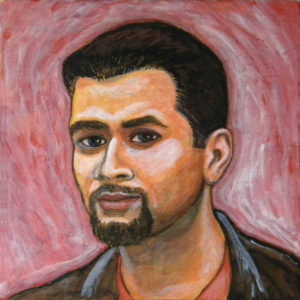 dimensional flesh on a 2-dimensional surface. So how did this come about? Suddenly last summer after a number of years of not doing any portraits at all, I painted two of them (featured in my posting of September 23 – Portraiture: Past Tense, Present Tense) working from photographs of a friend who sat for me. Since then my thoughts have increasingly turned to the fascination of the face,
dimensional flesh on a 2-dimensional surface. So how did this come about? Suddenly last summer after a number of years of not doing any portraits at all, I painted two of them (featured in my posting of September 23 – Portraiture: Past Tense, Present Tense) working from photographs of a friend who sat for me. Since then my thoughts have increasingly turned to the fascination of the face,
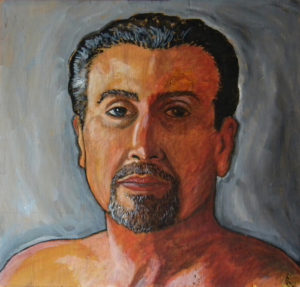 the locking of the eyes that happens between viewer and viewed in certain pieces of art. To explore the antiquity of that artistic device to connect the living with the dead through representation, I recently purchased an inspiring volume entitled “The Mysterious Fayum Portraits: Faces from Ancient Egypt” written by Euphrosyne Doxiadis. She reproduces a wealth of imagery from that
the locking of the eyes that happens between viewer and viewed in certain pieces of art. To explore the antiquity of that artistic device to connect the living with the dead through representation, I recently purchased an inspiring volume entitled “The Mysterious Fayum Portraits: Faces from Ancient Egypt” written by Euphrosyne Doxiadis. She reproduces a wealth of imagery from that
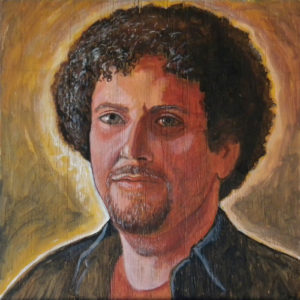 period plus provides a revealing text about these extraordinary Greek-artisan-created mummy portraits from the Coptic period in Rome-dominated Egypt, dating from the 1st to the 3rd centuries. Among the many things learned from my reading of Doxiadis’ informative and well-researched text was a fact which I found startling: these ancient portraits had been created using only four
period plus provides a revealing text about these extraordinary Greek-artisan-created mummy portraits from the Coptic period in Rome-dominated Egypt, dating from the 1st to the 3rd centuries. Among the many things learned from my reading of Doxiadis’ informative and well-researched text was a fact which I found startling: these ancient portraits had been created using only four
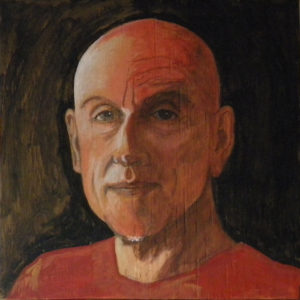 colors, the ones described above. Spurred to experiment I’ve been having a great time creating the portraits shown here, all created one after another within the last two weeks. I’m truly amazed at the variety of color I’ve been able to achieve with such a limited palette. I’m learning something new with every portrait worked on. Thanks to my friends for modeling for these portraits: father-and-son William and Will, Charlie, Frank & Warren, for being my first experimental sitters in this new and exciting exploration of a genre that, for too long, I have considered beyond my ken or my skill level. Since beginning this series, two more volumes dealing with portraiture have come into my hands which have challenged and inspired me in my quest. “Van Gogh Face to Face: The Portraits” – the catalog for a traveling exhibition that started at the Detroit Institute of Arts, moved to Boston’s Museum of Fine Arts, before heading to the Philadelphia Museum of Art where I saw this powerful show in the fall of 2000. This book too has been a revelation that has added immensely to my understanding and enjoyment of portraiture in general and van Gogh’s work in particular, stimulated by seeing that mesmerizing movie “Loving Vincent” a few weeks ago, which I touched upon in my most recent blog. The second volume worth mentioning is “Artist’s Self-portraits” with text by Omar Calabrese, a deluxe Abbeville Press production that is an outstanding example of beautifully designed book making. What a treat to immerse myself in some of the most outstanding portraits that have ever been created.
colors, the ones described above. Spurred to experiment I’ve been having a great time creating the portraits shown here, all created one after another within the last two weeks. I’m truly amazed at the variety of color I’ve been able to achieve with such a limited palette. I’m learning something new with every portrait worked on. Thanks to my friends for modeling for these portraits: father-and-son William and Will, Charlie, Frank & Warren, for being my first experimental sitters in this new and exciting exploration of a genre that, for too long, I have considered beyond my ken or my skill level. Since beginning this series, two more volumes dealing with portraiture have come into my hands which have challenged and inspired me in my quest. “Van Gogh Face to Face: The Portraits” – the catalog for a traveling exhibition that started at the Detroit Institute of Arts, moved to Boston’s Museum of Fine Arts, before heading to the Philadelphia Museum of Art where I saw this powerful show in the fall of 2000. This book too has been a revelation that has added immensely to my understanding and enjoyment of portraiture in general and van Gogh’s work in particular, stimulated by seeing that mesmerizing movie “Loving Vincent” a few weeks ago, which I touched upon in my most recent blog. The second volume worth mentioning is “Artist’s Self-portraits” with text by Omar Calabrese, a deluxe Abbeville Press production that is an outstanding example of beautifully designed book making. What a treat to immerse myself in some of the most outstanding portraits that have ever been created.
“When you realize the difference between the container and the content, you will have knowledge.” – Idries Shah (16 Jun 1924 – 23 Nov 1996)
 The Divine Lorraine Series: Awakened – Observed – Engaged – Transformed • acrylics and oils on MDF panels, framed in salvaged, stripped & refinished
The Divine Lorraine Series: Awakened – Observed – Engaged – Transformed • acrylics and oils on MDF panels, framed in salvaged, stripped & refinished
 window sashes, measuring 39″ x 30″ each, from the The Divine Lorraine, originally the Lorraine Apartments, at Broad St and Fairmount Ave in North Philadelphia. The renovation of this outstanding late-beaux-arts building is finally nearing completion after numerous years of false starts and delays which have kept this once elegant building from taking its rightful place again as a Philadelphia landmark of distinction.
window sashes, measuring 39″ x 30″ each, from the The Divine Lorraine, originally the Lorraine Apartments, at Broad St and Fairmount Ave in North Philadelphia. The renovation of this outstanding late-beaux-arts building is finally nearing completion after numerous years of false starts and delays which have kept this once elegant building from taking its rightful place again as a Philadelphia landmark of distinction.
2008: So what was I up to as a self-employed artist a decade ago with
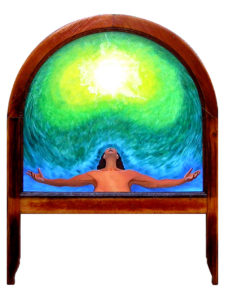 time on my hands, and lots of ideas in my head? After a period of intense diversionary creativity in the early-to-mid 2000s, during which I focused almost exclusively on my lamps – those over-the-top luminaries that I’m even more noted for in some circles than my paintings – I once again turned to the easel with renewed interest and vigor. One of the first projects of the new year 2008 was painting four panels to fill four empty window sashes which a friend had salvaged from the Divine Lorraine, and from which she only wanted the
time on my hands, and lots of ideas in my head? After a period of intense diversionary creativity in the early-to-mid 2000s, during which I focused almost exclusively on my lamps – those over-the-top luminaries that I’m even more noted for in some circles than my paintings – I once again turned to the easel with renewed interest and vigor. One of the first projects of the new year 2008 was painting four panels to fill four empty window sashes which a friend had salvaged from the Divine Lorraine, and from which she only wanted the
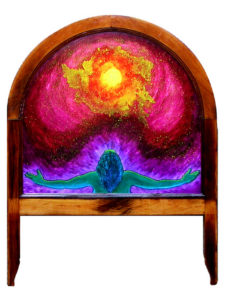 pebbled-textured translucent glass for a project of her own. Needless to say, when she offered me the sashes, beat up as they were, I jumped at the opportunity because I loved the arched shape of the sashes so much. I could already envision a series of paintings filling the voids left by the removal of the glass. Thereafter, I spent many an hour in the fall of 2007 stripping all four sashes of their numerous coats of paint, until I eventually got down to natural wood which showed the wear-and-tear aging of the years. The paintings themselves didn’t take nearly
pebbled-textured translucent glass for a project of her own. Needless to say, when she offered me the sashes, beat up as they were, I jumped at the opportunity because I loved the arched shape of the sashes so much. I could already envision a series of paintings filling the voids left by the removal of the glass. Thereafter, I spent many an hour in the fall of 2007 stripping all four sashes of their numerous coats of paint, until I eventually got down to natural wood which showed the wear-and-tear aging of the years. The paintings themselves didn’t take nearly
 as much time to create, as stripping the sashes in preparation for these colorful images. All are based on the theme of rapture, or exaltation; a theme that would probably be dear to the heart of Father Divine (1876-1965) the charismatic minister and early 20th century preacher who founded the Universal Peace Mission Movement. In 1948 he purchased the property which had originally been built between 1892-94 as the Lorraine Apartments, one of the first high-rise buildings in the city, and one of its most luxurious apartment buildings. This in turn had become the Lorraine Hotel in 1900. Father Divine, who has a very interesting history himself, turned the building into the Divine Lorraine, the first racially integrated hotel in Philadelphia, a landmark which experienced its heyday of fame during the middle decades of the 20th century. With Father Divine’s death in the mid-60s, the Hotel suffered a decline, was finally closed in the late 1990s, suffered the indignities of abandonment and salvage operations which stripped the building of much of its contents (including my window sashes) until 2012 when a developer finally started the last phases of renovation that draw to a close this year.
as much time to create, as stripping the sashes in preparation for these colorful images. All are based on the theme of rapture, or exaltation; a theme that would probably be dear to the heart of Father Divine (1876-1965) the charismatic minister and early 20th century preacher who founded the Universal Peace Mission Movement. In 1948 he purchased the property which had originally been built between 1892-94 as the Lorraine Apartments, one of the first high-rise buildings in the city, and one of its most luxurious apartment buildings. This in turn had become the Lorraine Hotel in 1900. Father Divine, who has a very interesting history himself, turned the building into the Divine Lorraine, the first racially integrated hotel in Philadelphia, a landmark which experienced its heyday of fame during the middle decades of the 20th century. With Father Divine’s death in the mid-60s, the Hotel suffered a decline, was finally closed in the late 1990s, suffered the indignities of abandonment and salvage operations which stripped the building of much of its contents (including my window sashes) until 2012 when a developer finally started the last phases of renovation that draw to a close this year.
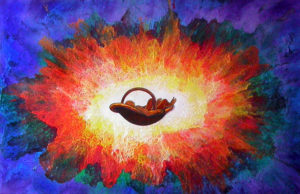 2007: To Hell in a Hand Basket • iridescent acrylics and oils on panel, approximately 14″ x 24″ • provenance unknown
2007: To Hell in a Hand Basket • iridescent acrylics and oils on panel, approximately 14″ x 24″ • provenance unknown
This piece and the others below, which have been featured in recent daily emails, were all created in
 2007, using found surfaces which I repurposed for art – table tops, drawers, miscellaneous plywood panels. Almost all these Big Bang abstractions were painted with the same iridescent acrylics that I have been using for years in my luminary work, on both metal and glass.
2007, using found surfaces which I repurposed for art – table tops, drawers, miscellaneous plywood panels. Almost all these Big Bang abstractions were painted with the same iridescent acrylics that I have been using for years in my luminary work, on both metal and glass.
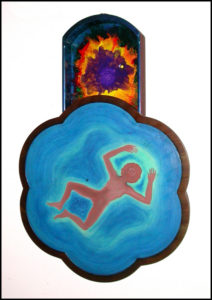

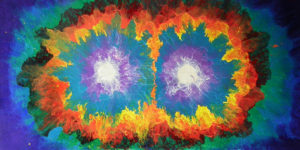


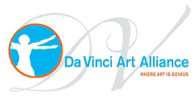

{ 1 comment… read it below or add one }
Hi Haven’t been getting to my emails with any degree of attention for quite a while. Something in this Warren portrait … do I see something of myself? Think more than craft calls forth a response. We should talk in person some time!